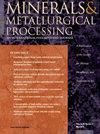工业铜电解精炼中电解液电导率模型的验证
Q2 Materials Science
引用次数: 3
摘要
电导率是一种典型的物理化学性质,对电精炼过程中的电能消耗有实质性的影响。本研究的目的是检验回归模型预测工业铜电精炼电解质电导率的有效性。这些模型是基于在实验室规模上用合成溶液测量的数据。模型中的变量包括温度和铜、镍、砷和硫酸的浓度。研究了各变量的一阶效应和联合效应。采用MODDE 8.0建模与设计软件对实测数据进行分析。通过将预测值与芬兰波里Boliden Harjavalta铜精炼厂的储罐电导率测量值进行比较,研究了模型的有效性。在槽室试验中,测量了工业电解液的电导率和温度,并分析了电解液的组成。将测量的电导率值与利用开发的模型计算的预测电导率进行了比较。本文建立的电导率模型比以前的模型更精确,适合工业应用。本文章由计算机程序翻译,如有差异,请以英文原文为准。
Validation of electrolyte conductivity models in industrial copper electrorefining
Conductivity is a typical physico-chemical property that has a substantial effect on electrical energy consumption in the electrorefining process. The objective of this study was to examine the validity of regression models predicting the conductivity of industrial copper electrorefining electrolytes. The models were based on data measured with synthetic solutions on a laboratory scale. The variables included in the models were temperature and the concentrations of copper, nickel, arsenic and sulfuric acid. Both first-order and combined effects of the variables were investigated. The measured data were analyzed using MODDE 8.0 modeling and design software. The validity of the models was investigated by comparing the predicted values with tankhouse conductivity measurements taken at the Boliden Harjavalta Copper Refinery in Pori in Finland. During the tankhouse tests, the conductivity and temperature of the industrial electrolyte were measured, and the composition of the electrolyte was analyzed. The measured conductivity values were compared with the predicted conductivities calculated using the developed models. The conductivity model developed in this paper was shown to be more accurate than previous models and suitable for industrial use.
求助全文
通过发布文献求助,成功后即可免费获取论文全文。
去求助
来源期刊

Minerals & Metallurgical Processing
工程技术-矿业与矿物加工
CiteScore
0.84
自引率
0.00%
发文量
0
审稿时长
>12 weeks
期刊介绍:
For over twenty-five years, M&MP has been your source for the newest thinking in the processing of minerals and metals. We cover the latest developments in a wide range of applicable disciplines, from metallurgy to computer science to environmental engineering. Our authors, experts from industry, academia and the government, present state-of-the-art research from around the globe.
 求助内容:
求助内容: 应助结果提醒方式:
应助结果提醒方式:


